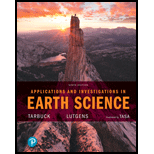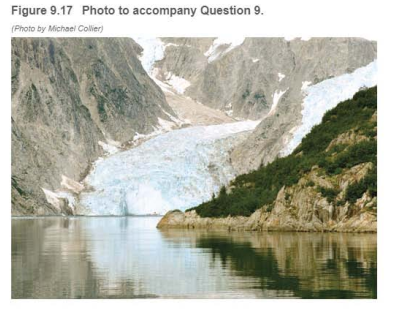
Applications and Investigations in Earth Science (9th Edition)
9th Edition
ISBN: 9780134746241
Author: Edward J. Tarbuck, Frederick K. Lutgens, Dennis G. Tasa
Publisher: PEARSON
expand_more
expand_more
format_list_bulleted
Textbook Question
Chapter 9, Problem 9LR
What type of glacier is shown In Figure 9.17?

Expert Solution & Answer
Learn your wayIncludes step-by-step video

schedule04:13
Students have asked these similar questions
While Chapters 8 and 9 consider almost purely endogenic processes, Chapter 10 takes us further out from the center of the Earth to exogenic processes. My sister and I were out for a walk
when we decided to cut through the cemetery. I could not help but wonder why the tombstones below are so different. While both tombstones are roughly the same age, the top one is made
out of limestone while the bottom one is made out of granite. However, the one above looks much older due to a difference in the rate of weathering. Limestone is made out of the mineral
calcite, CaCO3, calcium carbonate.
Reads "1884"
Dieds
JOSEPH HERRING
1842-1911
JULIA HERRING
1843
NELLIE HERRING
1870-1882
Reads "1882"
The tombstone in better condition here is made out of granite. Granite contains minerals such as quartz and feldspar. Both tombstones experience the same climate conditions and have been
exposed to exogenic processes for the same amount of time yet they look so different! Some research into Chapter 10…
Discussion Question: Tectonics, Earthquakes and Volcanism A+
The image below can also be found in your textbook. This image is not an interpretation but an actual picture of the Red Sea. This area of the world is the East African Rift Zone separating
Saudi Arabia and Africa. The linear pattern is due to extensional tectonics. In other words, Africa and Saudi Arabia are moving away from each other creating tensional forces that create
normal faults. The landscape features found in the area are Rift Valleys.
Pretend we are on location at the East African Rift Valley. We would find Normal Faults where one side of the fault shows a rock layer dropped relative to the other layer. We would find
linear mountains that formed from the valley dropping out between the normal faults. The microscale evidence we collect helps to add up to the macroscale interpretation of a divergent
boundary due to tensional forces creating normal faults and rift valleys.
Please explain why low clouds occur off of California’s coast during summer. In your explanation, please include the terms “Hadley Circulation,” “atmospheric subsidence,” and “ocean upwelling''
Chapter 9 Solutions
Applications and Investigations in Earth Science (9th Edition)
Ch. 9.1 - Indicate whether you think the following...Ch. 9.1 - Name the four deserts found in the United States.Ch. 9.2 - On the Antelope Peak topographic map, draw a line...Ch. 9.2 - Prob. 2ACh. 9.2 - Prob. 3ACh. 9.2 - Prob. 4ACh. 9.2 - Prob. 5ACh. 9.2 - Prob. 6ACh. 9.2 - Prob. 8ACh. 9.2 - Prob. 9A
Ch. 9.3 - What percentage of Earths land surface do glaciers...Ch. 9.3 - Identify two locations where ice sheets are...Ch. 9.3 - Briefly compare an ice sheet to a valley glacier.Ch. 9.4 - As a glacier retreats, it sometimes stalls and...Ch. 9.4 - On Figure 9.7, label an area covered by ground...Ch. 9.4 - On Figure 9.7, fill in the appropriate blanks with...Ch. 9.4 - Which area is composed of stratified drift: the...Ch. 9.5 - After examining the map and stereogram, draw a...Ch. 9.5 - What evidence on the map indicates that portions...Ch. 9.5 - Is the general topography of the land in Sections...Ch. 9.5 - Is the area that coincides with Kettle Moraine...Ch. 9.5 - The feature labeled A on the map is a long ridge...Ch. 9.5 - The streamlined, asymmetrical hills composed of...Ch. 9.5 - Prob. 8ACh. 9.5 - Using the features labeled B in Figure 9.10 as a...Ch. 9.5 - What is the likely location of the outwash plain...Ch. 9.5 - Label the area covered by ground moraine.Ch. 9.5 - What term is applied to the numerous almost...Ch. 9.6A - How does a glacier change the shape and depth of a...Ch. 9.6A - How is an arte different from a horn?Ch. 9.6A - Briefly describe the changes that occur in...Ch. 9.6B - Identify the glacial feature indicated by each of...Ch. 9.6B - A tarn is a lake that forms in a cirque. Of the...Ch. 9.6B - The feature marked G on the map is a depositional...Ch. 9.6B - Explain how Turquoise Lake likely formed....Ch. 9.6B - Use Figure 9.14 to draw a topographic profile...Ch. 9.6B - Describe the shape of Lake Fork Valley, based on...Ch. 9.6B - Prob. 7ACh. 9 - Name the area of the United States that is...Ch. 9 - Identify the feature shown by the arrows in Figure...Ch. 9 - List some prominent features found in mountainous...Ch. 9 - Toward what general direction does the landscape...Ch. 9 - If you were working in the field, explain how you...Ch. 9 - Prob. 6LRCh. 9 - What reason did you give for the formation of...Ch. 9 - Use Figure 9.16 an image of Alaskas Bear Glacier,...Ch. 9 - What type of glacier is shown In Figure 9.17?Ch. 9 - Use Figure 9.18 to complete the following. a....
Additional Science Textbook Solutions
Find more solutions based on key concepts
In one public health study, replica plating was used to screen 131 fecal samples for gram-negative bacteria tha...
Laboratory Experiments in Microbiology (12th Edition) (What's New in Microbiology)
A source of electromagnetic radiation produces infrared light. Which of the following could be the wavelength ...
Chemistry: The Central Science (14th Edition)
Choose the best answer to each of the following. Explain your reasoning. Which of the following was not a major...
Cosmic Perspective Fundamentals
A 300 g bird flying along at 6.0 m/s sees a 10 g insect heading straight toward it at a speed of 30 m/s. The bi...
Physics for Scientists and Engineers: A Strategic Approach, Vol. 1 (Chs 1-21) (4th Edition)
Which of the following factors would tend to increase membrane fluidity? A. a greater proportion of unsaturated...
Campbell Biology in Focus (2nd Edition)
1.3 Obtain a bottle of multivitamins and read the list of ingredients. What are four chemicals from the list?
Chemistry: An Introduction to General, Organic, and Biological Chemistry (13th Edition)
Knowledge Booster
Similar questions
- In Sequoia National Park, why does soil moisture increase in April even though precipitation totals are on average lower in April than in March?arrow_forwardThe continents are net importers of precipitation from the oceans. We know this because, while only 15% of global evaporation occurs from the continents, the continents receive 23% of the globe’s precipitation. How is this discrepancy sustainable without the continents filling up with water and the oceans emptying out?arrow_forward6) Just 15% of global evaporation occurs over the continents even though the continents cover about 29% of the earth’s surface. Why is the proportion of global evaporation that occurs on continents less than 29%?arrow_forward
- What are the four elements of a local water budget ? Assuming all else is held equal, what is the effect of warming on the atmosphere’s ability to evaporate water from soils and vegetation? What happens to the amount of water stored in the soil if warming affects evapotranspiration in the way you described above and there is no change to runoff?arrow_forwardThe map below shows the age of the ocean floor (time since the crust was formed). Why do we find the youngest ocean crust at the mid-ocean ridges? Why does the oldest crust tend to be near continental coasts?arrow_forwardwhat is a main piece of evidence that the continents were once all connected in a single super continent 200–300 million years ago? What was the main role of plate tectonics in breaking up this super continentarrow_forward
- What might occur when humans overuse the natural resources of a space or habitat? Question 2 options: Environmental Stability Species Extinction Resource Regeneration Ecological Deficitarrow_forwardWhat does natural capital include? Question 3 options: Water, Land, Air Renewable resources Non-renewable resources Culture heritagearrow_forwardNatural Gas is a renewable natural resource. Question 1 options: True Falsearrow_forward
- Please help as soon as possible. I have an answer for this, but I'm a bit confused, so any extra assistance would be appreciated! Complete the cross sections on the front and side of the block diagram in Figure 6.6. Complete the cross-section of the side of the block diagram in Figure 6.7. Complete the front and side of the block diagram in Figure 6.8arrow_forwarda. Draw four sedimentary layers of equal thickness that have a strike of N90°E. (Hint: Sketch the map view first.)b. Each layer is dipping to the south at an angle of 60°.c. On the block diagram complete the map view and both cross-sectional views.d. Add strike-dip symbols for each rock layer on both parts of Figure 6.9.arrow_forwardThere is an old axiom (a self-evident or universally recognized truth) of economics that “There is no such thing as a free lunch”. In the United States, stringent, enforced water quality laws and regulations provide a high level of protection of our waters. This is accomplished at a significant cost. For example, (sewage treatment plants use 2% of the electricity produced in the United States. This high level of protection increases the cost of goods manufactured in the United States compared to other nations such as China where standards are lower, enforcement a bit lax and in some cases, non-existent. What five (5) things could be done to “level the playing field” so that all manufacturers must provide the same degree of water quality protection no matter where in the world they are located? include how each of your ideas will be implemented (ex: which organization will be provided the power and resources to make sure each idea happens). These should be only about water pollution,…arrow_forward
arrow_back_ios
SEE MORE QUESTIONS
arrow_forward_ios
Recommended textbooks for you
 Applications and Investigations in Earth Science ...Earth ScienceISBN:9780134746241Author:Edward J. Tarbuck, Frederick K. Lutgens, Dennis G. TasaPublisher:PEARSON
Applications and Investigations in Earth Science ...Earth ScienceISBN:9780134746241Author:Edward J. Tarbuck, Frederick K. Lutgens, Dennis G. TasaPublisher:PEARSON Exercises for Weather & Climate (9th Edition)Earth ScienceISBN:9780134041360Author:Greg CarbonePublisher:PEARSON
Exercises for Weather & Climate (9th Edition)Earth ScienceISBN:9780134041360Author:Greg CarbonePublisher:PEARSON Environmental ScienceEarth ScienceISBN:9781260153125Author:William P Cunningham Prof., Mary Ann Cunningham ProfessorPublisher:McGraw-Hill Education
Environmental ScienceEarth ScienceISBN:9781260153125Author:William P Cunningham Prof., Mary Ann Cunningham ProfessorPublisher:McGraw-Hill Education Earth Science (15th Edition)Earth ScienceISBN:9780134543536Author:Edward J. Tarbuck, Frederick K. Lutgens, Dennis G. TasaPublisher:PEARSON
Earth Science (15th Edition)Earth ScienceISBN:9780134543536Author:Edward J. Tarbuck, Frederick K. Lutgens, Dennis G. TasaPublisher:PEARSON Environmental Science (MindTap Course List)Earth ScienceISBN:9781337569613Author:G. Tyler Miller, Scott SpoolmanPublisher:Cengage Learning
Environmental Science (MindTap Course List)Earth ScienceISBN:9781337569613Author:G. Tyler Miller, Scott SpoolmanPublisher:Cengage Learning Physical GeologyEarth ScienceISBN:9781259916823Author:Plummer, Charles C., CARLSON, Diane H., Hammersley, LisaPublisher:Mcgraw-hill Education,
Physical GeologyEarth ScienceISBN:9781259916823Author:Plummer, Charles C., CARLSON, Diane H., Hammersley, LisaPublisher:Mcgraw-hill Education,

Applications and Investigations in Earth Science ...
Earth Science
ISBN:9780134746241
Author:Edward J. Tarbuck, Frederick K. Lutgens, Dennis G. Tasa
Publisher:PEARSON

Exercises for Weather & Climate (9th Edition)
Earth Science
ISBN:9780134041360
Author:Greg Carbone
Publisher:PEARSON

Environmental Science
Earth Science
ISBN:9781260153125
Author:William P Cunningham Prof., Mary Ann Cunningham Professor
Publisher:McGraw-Hill Education

Earth Science (15th Edition)
Earth Science
ISBN:9780134543536
Author:Edward J. Tarbuck, Frederick K. Lutgens, Dennis G. Tasa
Publisher:PEARSON

Environmental Science (MindTap Course List)
Earth Science
ISBN:9781337569613
Author:G. Tyler Miller, Scott Spoolman
Publisher:Cengage Learning

Physical Geology
Earth Science
ISBN:9781259916823
Author:Plummer, Charles C., CARLSON, Diane H., Hammersley, Lisa
Publisher:Mcgraw-hill Education,